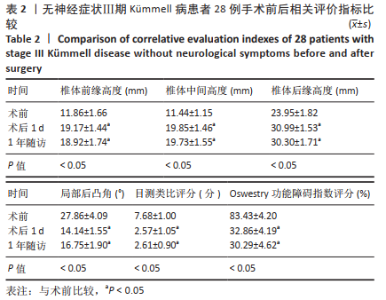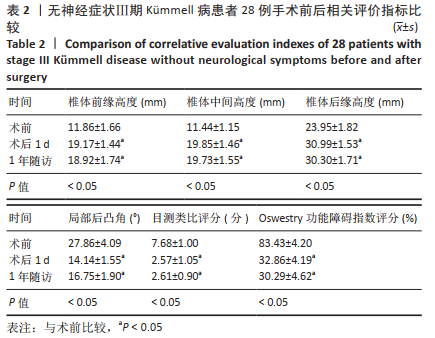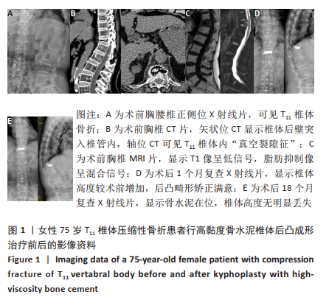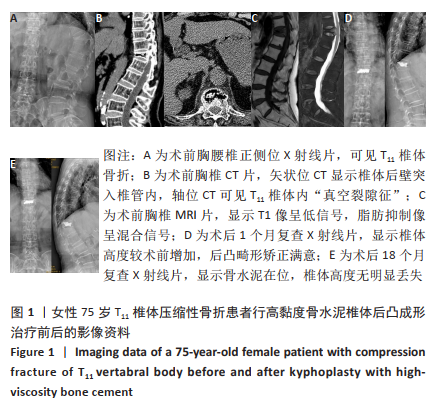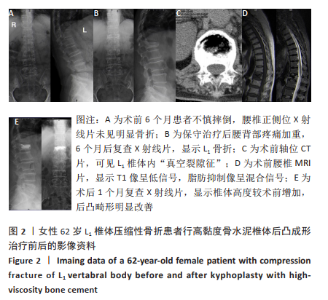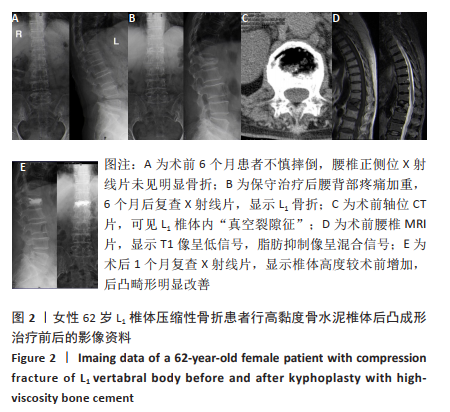[1] PARK SJ, KIM HS, LEE SK, et al. Bone Cement-Augmented Percutaneous Short Segment Fixation: An Effective Treatment for Kummell’s Disease? J Korean Neurosurg Soc. 2015;58(1):54-59.
[2] SUN K, LIU Y, PENG H, et al. A comparative study of high-viscosity cement percutaneous vertebroplasty vs. low-viscosity cement percutaneous kyphoplasty for treatment of osteoporotic vertebral compression fractures. J Huazhong Univ Sci Technolog Med Sci. 2016; 36(3):389-394.
[3] HUANG Y, PENG M, HE S, et al. Clinical Efficacy of Percutaneous Kyphoplasty at the Hyperextension Position for the Treatment of Osteoporotic Kümmell Disease. J Clin Spine Surg. 2016;29(4):161-166.
[4] HUANG Y, HAO D, FENG H, et al. Comparison of Percutaneous Kyphoplasty and Bone Cement-Augmented Short-Segment Pedicle Screw Fixation for Management of Kümmell Disease. J Med Sci Monit. 2018;24:1072-1079.
[5] 张亮,王静成,冯新民,等.高粘度骨水泥椎体成形术与普通粘度椎体后凸成形术治疗骨质疏松性椎体压缩性骨折的效果比较[J].中国老年学杂志,2017,37(18):4601-4603.
[6] LI K, LI A F, HSIEH C, et al. Another option to treat Kümmell’s disease with cord compression. J Eur Spine J. 2007;16(9):1479-1487.
[7] 李江笔,那士博,公伟权,等.Kümmell病的临床治疗进展[J].中国骨伤,2020,33(1):81-86.
[8] 孙亦强,王秀双,李建军,等.椎体内裂隙征引起的椎体动态不稳与神经功能损伤的关系[J].中国组织工程研究,2020,24(18): 2900-2905.
[9] 韩雷,全仁夫,孙观荣,等.经皮后路短节段椎弓根螺钉固定联合椎体成形术治疗无神经损伤Ⅲ期Kümmell病[J].中华创伤杂志, 2019,35(6):508-512.
[10] FENG S, CHANG M, WU H, et al. Are intravertebral vacuum phenomena benign lesions? J Eur Spine J. 2011;20(8):1341-1348.
[11] KIM JE, CHOI SS, LEE MK, et al. Failed Percutaneous Vertebroplasty Due to Insufficient Correction of Intravertebral Instability in Kummell’s Disease: A Case Report. J Pain Pract. 2017;17(8):1109-1114.
[12] 赖欧杰,胡勇,袁振山,等.伤椎椎体成形联合后路融合固定术治疗Ⅲ期Kümmell病[J].中医正骨, 2018,30(6):72-75.
[13] 郝晨,韩来春,史洁,等.单侧PVP术治疗Ⅲ期无神经症状Kummell病的临床疗效[J].实用骨科杂志, 2020,26(4):343-347.
[14] 刘义杰,杨森,李雪峰,等.经皮椎体后凸成形术治疗无神经症状性Ⅲ期Kümmell病[J].中华创伤骨科杂志,2019,21(10):888-893.
[15] YU WB, JIANG XB, LIANG D, et al. Risk factors and score for recollapse of the augmented vertebrae after percutaneous vertebroplasty in osteoporotic vertebral compression fractures. J Osteoporos Int. 2019;30(2):423-430.
[16] 蔡金辉,刘庆余,阮耀钦,等.经皮椎体强化术后骨水泥椎间盘渗漏与邻近椎体骨折的相关性分析[J]. 中国脊柱脊髓杂志,2018, 28(8):713-719.
[17] KRAUSS M, HIRSCHFELDER H, TOMANDL B, et al. Kyphosis reduction and the rate of cement leaks after vertebroplasty of intravertebral clefts. J Eur Radiol. 2006;16(5):1015-1021.
[18] JUNG JY, LEE MH, AHN JM. Leakage of polymethylmethacrylate in percutaneous vertebroplasty: comparison of osteoporotic vertebral compression fractures with and without an intravertebral vacuum cleft. J Comput Assist Tomogr. 2006;30(3):501-506.
[19] 曹奇,唐晓军,杨铁军,等.经皮椎体成形术治疗Kümmell’s病后发生邻近椎体骨折的原因分析[J].中国骨质疏松杂志,2012,18(9): 833-836.
[20] 杨惠林,王根林,姜为民,等.分次灌注骨水泥技术治疗Kümmell病[J].脊柱外科杂志,2012,10(1): 22-24.
[21] BAROUD G, CROOKSHANK M, BOHNER M. High-viscosity cement significantly enhances uniformity of cement filling in vertebroplasty: an experimental model and study on cement leakage. J Spine (Phila Pa 1976). 2006;31(22):2562-2568.
[22] 房根强,赵正历,靳宪辉,等.高黏度骨水泥椎体成形治疗骨质疏松性椎体压缩骨折[J].中国组织工程研究,2019,23(22):3475-3480.
[23] 张建乔,曾忠友,宋永兴,等.经皮椎体后凸成形和椎体成形术治疗老年人无神经损伤Ⅲ期Kümmell’s病的临床观察[J].中华老年医学杂志,2018,37(3):301-305.
[24] 赵永生,李强,历强,等.骨水泥弥散类型对治疗骨质疏松性椎体压缩骨折的影响[J].中国骨伤,2017,30(5):446-452. |
